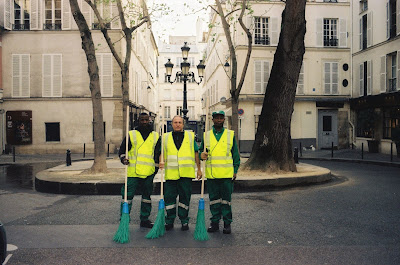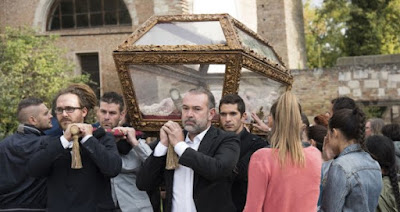As the new documentary UNMARKED shows us, there are hundreds of slave cemeteries -- until now allowed to disappear or slip into total disrepair -- seemingly unknown yet almost in plain view that dot our southern states, particularly in the area of Virginia, where this documentary takes place.
As directed by Chris Haley (shown at right) and Brad J. Bennett (below), the documentary is actually a short film which started out, according to its IMDB page, as only 27 minutes in length, now grown to 40 minutes. And yet, the subject itself calls for full-length treatment.Perhaps because the venue is confined (probably by both the budget the location of the filmmakers to the state of Virginia), the ability to reach out nationwide was limited. And so we remain in and around that state, as these new/old graveyards are rediscovered and
reinvigorated from the confines of the natural world that has grown around them and covered them.Catch as catch can, we meet some of the folk who are helping unearth and then maintain these graveyards, and we watch them work and see how they manage all this.
It's interesting, important, and -- when at one point we view the pristine and beautifully-tended Confederate cemetery in the area of Richmond, VA -- fucking enraging to compare this to the separate-but-unequal "disappeared" cemetery of the slaves.
Most of the documentary will not and is not meant to be enraging because it is clear that the folk working to regain these burial grounds and turn them into something that honors, records and remembers the dead want to do this as peaceably as possible.
This means using the help of mostly volunteers but also politicians and local institutions -- educational and otherwise -- in ways that might finally bring us together, at least somewhat.
So we watch as these volunteers, using only their bare hands against the under- and over-growth, discover more tombstones in more locations. One woman speaks movingly of finally traveling the road from shame to pride regarding the history of slavery, while another remarks on how important it is to possess "authentic history," rather than merely history (or the kind of revisionist history that would have us believe that so many of the slaves were such happy people, really.).
If the doc jumps around into subjects barely covered, and even includes an apocryphal-sounding tale of a sad "Cinderella" love story, its heart is clearly in the right place. Let's hope that a full-length documentary may someday arrive covering more of the totality and history of these unmarked graves. Meanwhile, this short film will fill you in as a decent introduction.
From First Run Features and lasting but 40 minutes, Unmarked arrived on DVD and digital streaming this past Tuesday, April 27 -- for purchase and/or rental. Click here for further information.























































